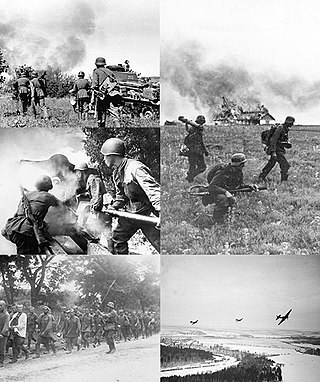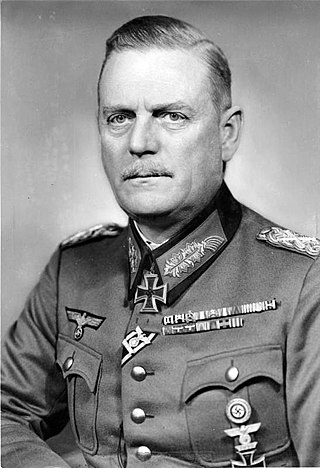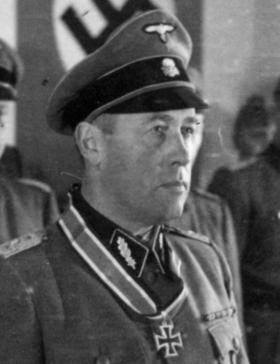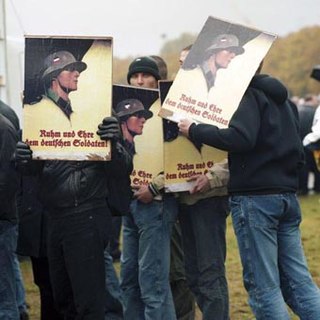Related Research Articles

Operation Barbarossa was the invasion of the Soviet Union by Nazi Germany and many of its Axis allies, starting on Sunday, 22 June 1941, during the Second World War. It was the largest land offensive in human history, with around 10 million combatants taking part.

Wilhelm Bodewin Johann Gustav Keitel was a German field marshal who held office as chief of the Oberkommando der Wehrmacht (OKW), the high command of Nazi Germany's armed forces, during World War II. He signed a number of criminal orders and directives that led to numerous war crimes.

The Commissar Order was an order issued by the German High Command (OKW) on 6 June 1941 before Operation Barbarossa. Its official name was Guidelines for the Treatment of Political Commissars. It instructed the Wehrmacht that any Soviet political commissar identified among captured troops be summarily executed as a purported enforcer of the so-called Judeo-Bolshevism ideology in military forces. It is one of a series of criminal orders issued by the Nazi leadership.

Arthur Nebe was a German SS functionary who held key positions in the security and police apparatus of Nazi Germany and was, from 1941, a major perpetrator of the Holocaust.

Walter Karl Ernst August von Reichenau was a German Generalfeldmarschall in the Heer (Army) of Nazi Germany during World War II. He was nicknamed "The Bull." Reichenau commanded the 6th Army, during the invasions of Belgium and France. During Operation Barbarossa, the invasion of the Soviet Union, he continued to command the 6th Army as part of Army Group South as it captured Ukraine and advanced deep into USSR.

During World War II, the German Wehrmacht committed systematic war crimes, including massacres, mass rape, looting, the exploitation of forced labour, the murder of three million Soviet prisoners of war, and participated in the extermination of Jews. While the Nazi Party's own SS forces was the organization most responsible for the genocidal killing of the Holocaust, the regular armed forces of the Wehrmacht committed many war crimes of their own, particularly on the Eastern Front.

Gustav Lombard was a high-ranking member in the SS during World War II. During the war, Lombard commanded 8th SS Cavalry Division Florian Geyer and the 31st SS Volunteer Grenadier Division. He was a recipient of the Knight's Cross of the Iron Cross of Nazi Germany for so-called "anti-partisan" operations around Kovel which involved killing of civilians and burning down villages.
The Geheime Feldpolizei, shortened to GFP, was the secret military police of the German Wehrmacht until the end of the Second World War (1945). Its units carried out plainclothes and undercover security work in the field. Their operations included clandestine operations, counterpropaganda, counterinsurgency, counterintelligence, creation of a counterinsurgency intelligence network, detection of treasonable activities, infiltration of resistance movements, gathering intelligence and destroying targets, protecting military installations, assisting the German Army (Heer) in courts-martial investigations, tracking and raiding targets to capture or kill, and setting-up security checkpoints in high-risk areas. GFP personnel, who were also classed as Abwehrpolizei, operated as an executive branch of the Abwehr, detecting resistance activity in Germany and in occupied France. They were also known to carry out torture and executions of prisoners.

The Wehrmacht were the unified armed forces of Nazi Germany from 1935 to 1945. It consisted of the Heer (army), the Kriegsmarine (navy) and the Luftwaffe. The designation "Wehrmacht" replaced the previously used term Reichswehr and was the manifestation of the Nazi regime's efforts to rearm Germany to a greater extent than the Treaty of Versailles permitted.

The myth of the clean Wehrmacht is the negationist notion that the regular German armed forces were not involved in the Holocaust or other war crimes during World War II. The myth, heavily promoted by German authors and military personnel after World War II, completely denies the culpability of the German military command in the planning and perpetration of war crimes. Even where the perpetration of war crimes and the waging of an extermination campaign, particularly in the Soviet Union – where the Nazis viewed the population as "sub-humans" ruled by "Jewish Bolshevik" conspirators – has been acknowledged, they are ascribed to the "Party soldiers corps", the Schutzstaffel (SS), but not the regular German military.

During World War II, the Barbarossa decree was one of the Wehrmacht's criminal orders given on 13 May 1941, shortly before Operation Barbarossa, the invasion of the Soviet Union. The decree was laid out by Adolf Hitler during a high-level meeting with military officials on March 30, 1941, where he declared that the upcoming war against the Soviets would be a war of extermination, in which both the political and intellectual elites of Russia would be eradicated by German forces, in order to ensure a long-lasting German victory. Hitler underlined that executions would not be a matter for military courts, but for the organised action of the military. The decree, issued by Field Marshal Wilhelm Keitel a few weeks before Barbarossa, exempted punishable offences committed by enemy civilians from the jurisdiction of military justice. Suspects were to be brought before an officer who would decide if they were to be shot. Prosecution of offenses against civilians by members of the Wehrmacht was decreed to be "not required" unless necessary for the maintenance of discipline.

Max von Schenckendorff was a general in the Wehrmacht of Nazi Germany during World War II. He was the commander of Army Group Rear Area behind Army Group Centre from March 1941 until his death. He is best known for organising the Mogilev conference, in which Wehrmacht and SS officers discussed "bandit fighting" tactics, meaning the mass murder of Jews and other real or perceived enemies. The conference resulted in an intensification of the genocide that was already taking place in Army Group Centre Rear Area.
Army Group Rear Area Command was an area of military jurisdiction behind each of the three Wehrmacht army groups from 1941, the German invasion of the Soviet Union in Operation Barbarossa, through 1944 when the pre-war territories of the Soviet Union were recovered. The areas were sites of mass murder during the Holocaust and other crimes against humanity targeting the civilian population.
The Mogilev Conference was a September 1941 Wehrmacht training event aimed at improving security in the rear of Army Group Centre during the German invasion of the Soviet Union. The event was organised by General Max von Schenckendorff, commander of Army Group Centre Rear Area, in cooperation with the officials of the security and intelligence services of Nazi Germany—SS and the Sicherheitsdienst —operating in the same area. Ostensibly an "anti-partisan" training conference, the event marked an escalation of violence against Jews and other civilians in the areas under Schenckendorff's command.

The Police Regiment Centre was a formation of the Order Police during the Nazi era. During Operation Barbarossa, it was subordinated to the Schutzstaffel (SS) and deployed in German-occupied areas, specifically the Army Group Centre Rear Area, of the Soviet Union. In mid-1942, its three constituent battalions were reassigned and the unit was re-designated as the 13th Police Regiment.

Marching into Darkness: The Wehrmacht and the Holocaust in Belarus is a book by the American historian Waitman Wade Beorn, published in 2014 by Harvard University Press. It discusses the participation of the German Wehrmacht in the Holocaust and other crimes against humanity during the course of the early stages of the German-Soviet War (1941–45).

In German military history, Bandenbekämpfung, also referred to as Nazi security warfare during World War II, refers to the concept and military doctrine of countering resistance or insurrection in the rear area during wartime with extreme brutality. The doctrine provided a rationale for disregarding the established laws of war and for targeting any number of groups, from armed guerrillas to civilians, as "bandits" or "members of gangs". As applied by the German Empire and later Nazi Germany, it became instrumental in the crimes against humanity committed by the two regimes, including the Herero and Nama genocide and the Holocaust.
The Police Battalion 322 was a formation of the German Order Police during the Nazi era. During Operation Barbarossa, it was subordinated to the SS and deployed in German-occupied areas, specifically the Army Group Centre Rear Area, of the Soviet Union, as part of Police Regiment Centre.
The Police Battalion 307 was a formation of the Order Police during the Nazi era. During Operation Barbarossa, it was subordinated to the SS and deployed in German-occupied areas, specifically the Army Group Centre Rear Area, of the Soviet Union, as part of Police Regiment Centre. Alongside detachments from the Einsatzgruppen, it perpetrated mass murder in the Holocaust and was responsible for large-scale crimes against humanity targeting civilian populations. In mid-1942, the battalion was reassigned to the 23rd Police Regiment and operated in Belarus.
Criminal orders is the collective name given to a series of orders, directives and decrees given before and during the German invasion of the Soviet Union in World War II by the Wehrmacht High Command. The criminal orders went beyond established codes of conduct and led to widespread atrocities on the Eastern Front.
References
- ↑ "Resources on the German Military" (PDF). Yad Vashem.
- ↑ Heer et al. 2008, pp. 19.
- ↑ Heer et al. 2008, pp. 17–19.
- ↑ "Excerpts from "Guidelines for the Conduct of the Troops in Russia" (May 19, 1941)". Kirkwood Community College. Archived from the original on 11 February 2024.
- ↑ Beorn 2014, p. 52.